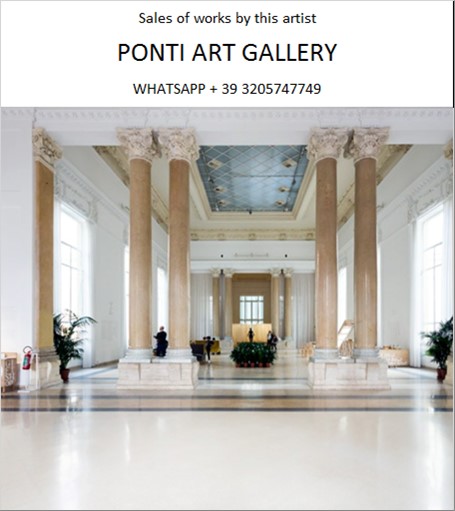Ponti Art Gallery is interested in buying and selling works
of art by this artist.

Antonio Sant-Elia Biography
Antonio Sant'Elia, born on April 30, 1888, in Como, Lombardy, emerged as a pivotal figure in the realm of architecture, leaving an indelible mark on the Futurist movement despite his brief life. His father, Luigi Sant'Elia, a barber, and his mother, Cristina Panzillo, provided a modest upbringing for Antonio and his siblings. From an early age, Sant'Elia exhibited a profound interest in the burgeoning field of architecture, which was further nurtured by the vibrant and technologically advancing environment of Como.
In 1903, at the tender age of 15, Sant'Elia embarked on his formal education in construction at the Istituto Gabriele Castellini in Como. His studies there laid the groundwork for his future endeavors, focusing on practical aspects of building and design. Upon graduating in 1906, Sant'Elia moved to Milan, a city at the forefront of technological innovation and industrial growth. It was here that he secured his first job as a site manager on the Villoresi Canal project, which exposed him to the challenges and opportunities of urban development.
Driven by a passion for architecture, Sant'Elia left his job to pursue higher education at the Fine Arts Academy of Brera. His time at the academy was marked by interactions with fellow students who would later become prominent figures in the Futurist movement. Despite not completing his second year, Sant'Elia's exposure to various architectural styles and theories during his travels, particularly to Rome and Vienna, significantly influenced his architectural vision.
Sant'Elia's career took a decisive turn in 1912 when he opened a design office in Milan and became involved with the Futurist movement. His association with the movement was solidified through his interactions with Filippo Tommaso Marinetti, the ideological founder of Futurism. Sant'Elia's vision for a modern, industrialized city, encapsulated in his series of drawings for the "Città Nuova" or "New City," showcased his belief in the integration of technology and architecture to create dynamic, futuristic urban environments.
His designs, characterized by monumental skyscrapers, interconnected levels of traffic, and innovative use of materials like glass, steel, and concrete, were revolutionary. Sant'Elia's architectural philosophy was articulated in the "Manifesto of Futurist Architecture," published in 1914, which emphasized the need for a break from traditional architectural forms and the embrace of modernity and mechanization.
Tragically, Sant'Elia's life and career were cut short when he volunteered for military service during World War I. He died in battle near Monfalcone on October 10, 1916, at the age of 28. Despite his premature death, Sant'Elia's visionary ideas and drawings have had a lasting impact on the field of architecture and beyond. His work anticipated many of the principles of modern architecture and urban planning, influencing subsequent generations of architects and designers.
Sant'Elia's legacy is preserved in the collections of his drawings housed in institutions such as the Pinacoteca Civica di Palazzo Volpi in Como. His visionary cityscapes continue to inspire and captivate, serving as a testament to his innovative spirit and his profound understanding of the potential of architecture to shape the future. Sant'Elia's influence extends beyond architecture, impacting the realms of cinema and popular culture, with his futuristic visions echoed in films like Fritz Lang's "Metropolis" and Ridley Scott's "Blade Runner."
In conclusion, Antonio Sant'Elia remains a seminal figure in the history of modern architecture. His bold ideas and visionary designs, though largely unrealized, have cemented his status as a pioneer of the Futurist movement and a prophet of the modern, industrial future. Sant'Elia's work continues to inspire and challenge, embodying the spirit of innovation and the relentless pursuit of progress that defines the essence of Futurism.
Antonio Sant-Elia Quotes and
Sales of Works
Ponti Art Gallery selects and deals with paintings by the
artist. Upon request, we provide free estimates and
evaluations, communicate prices, quotations, and current
market values.
If you are interested in BUYING or SELLING works by the
artist, contact us immediately.
If you wish to sell or receive an evaluation of the
works:
Send us a frontal photo of the painting, one of the back,
and one of the signature. Also, indicate the dimensions of
the work. Inform us about the purchase origin of the work
and any kind of available documentation (purchase
receipts, certificates of authenticity, publications). One
of our operators will respond to you on the same day. We
guarantee maximum confidentiality and extreme
professionalism.
If you wish to purchase works by the painter: Contact us
and let us know your request. We will inform you about the
available works. We also offer the possibility to
subscribe to our NEWSLETTER, through which you will be
informed at the beginning of each month about the latest
acquisitions of the art gallery.
You can send us pictures of the work:
